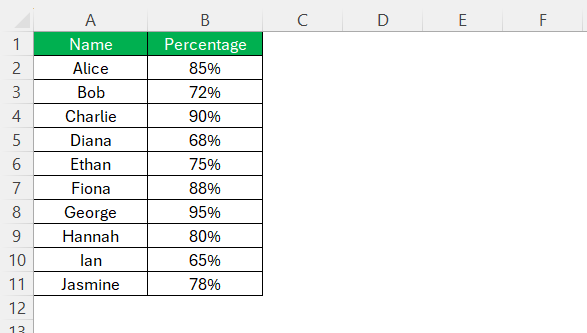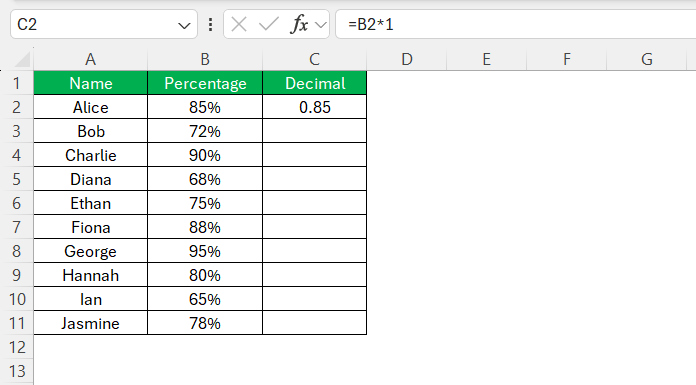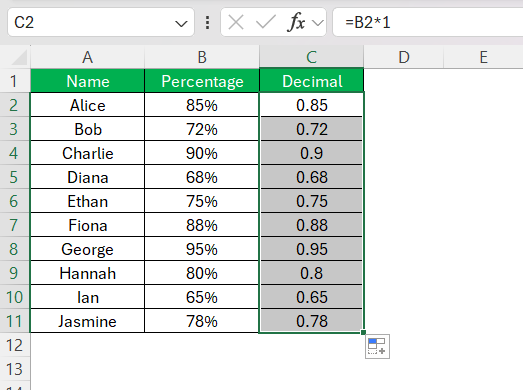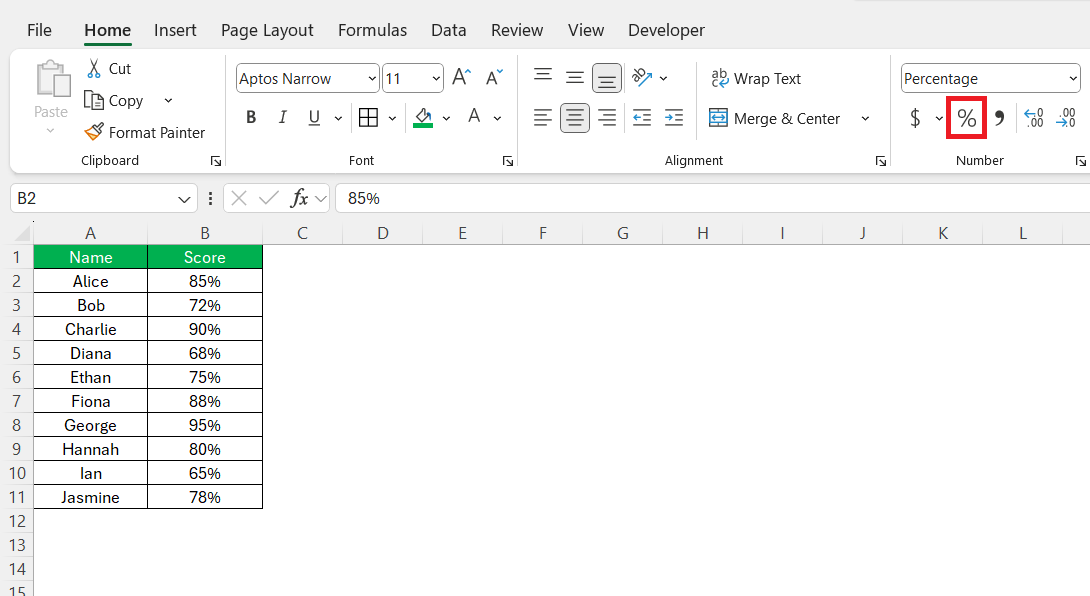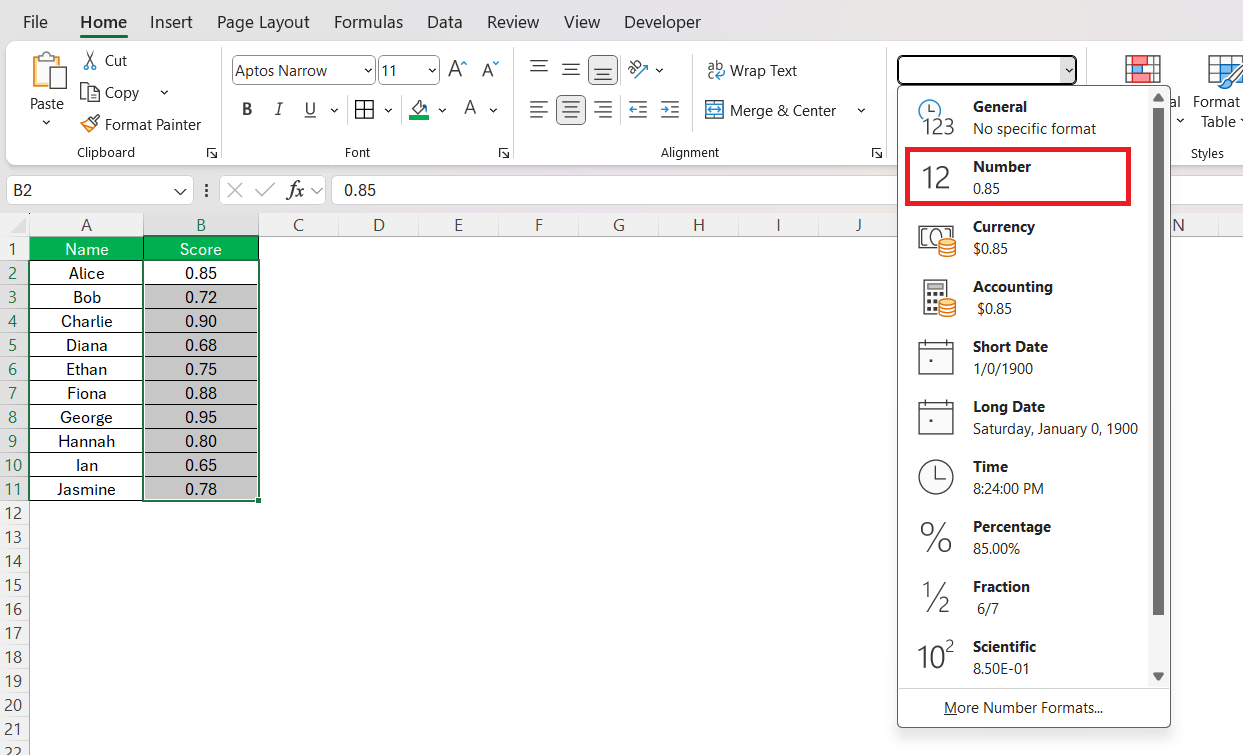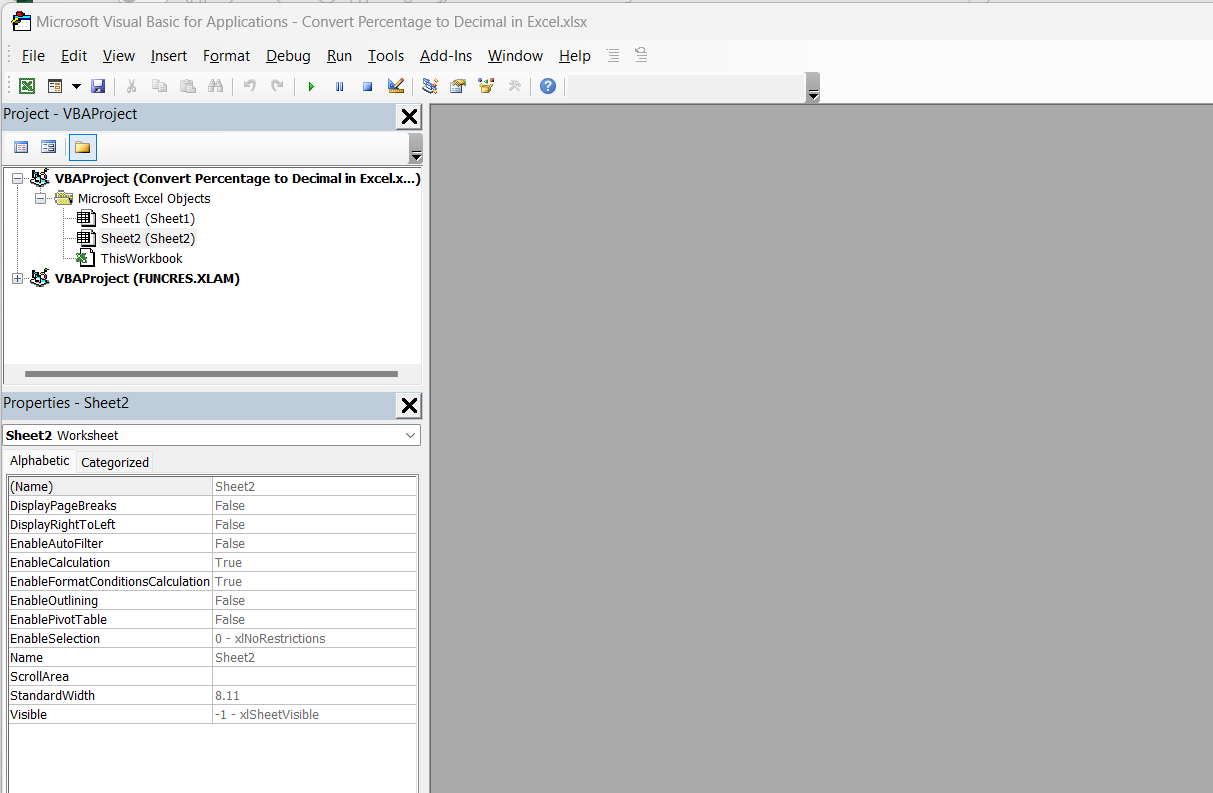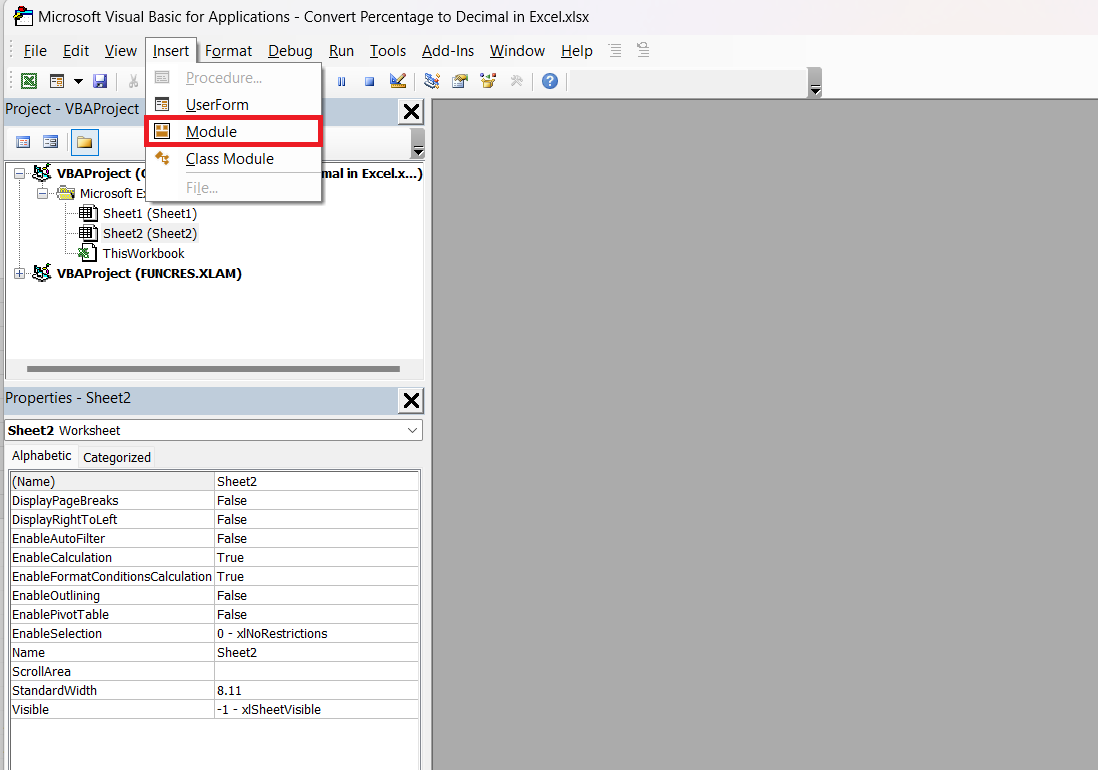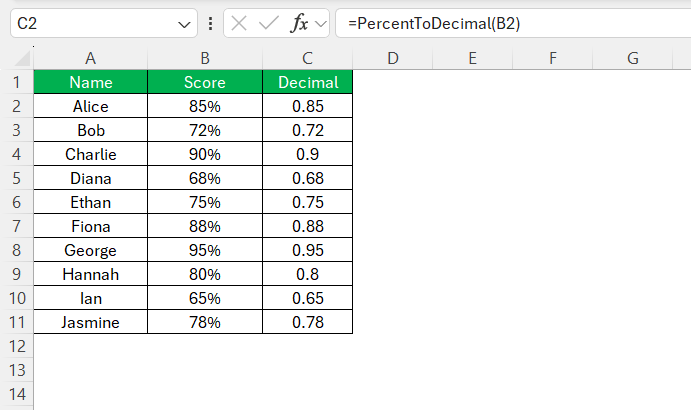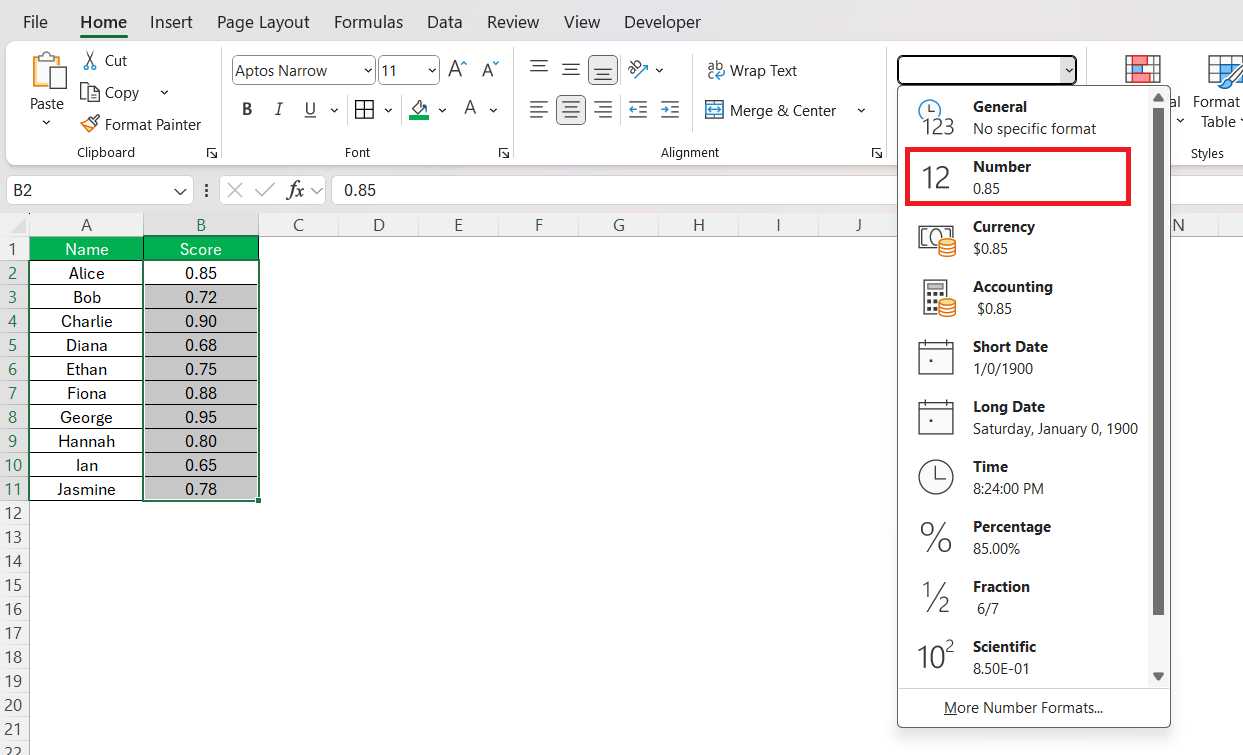As someone who often works with data in Excel, I frequently come across scenarios where I need to convert percentages to decimals. This is a common requirement, especially when dealing with financial calculations, data analysis, or scientific computations. The good news is that Excel makes this process incredibly straightforward. Let me walk you through how to do it step by step.
Key Takeaways:
- Excel Reads Percentages as Fractions: Typing
50%means Excel stores it as0.5. - Decimal Conversion Ensures Accuracy: Converting percentages allows for precise calculations.
- Multiple Methods for Conversion: Use multiplication, format changes, or custom VBA functions.
- Avoid Errors During Conversion: Check cell formats and prevent rounding issues.
- Useful for Data Analysis: Decimals simplify financial and statistical computations
Table of Contents
Introduction to Percent and Decimal Conversion in Excel
Understanding the Basics of Percentages in Excel
In Excel, a percentage is essentially a fraction expressed as a part of a hundred. Understanding how Excel interprets and formats percentages is crucial for any spreadsheet manipulation task. Whenever we enter a number followed by the percentage sign (%), Excel automatically reads it as a hundredth of its value – meaning, if we type in 50%, Excel understands it as 0.5.
This is handy to grasp when we’re planning to convert and manipulate data involving percentages.
The Importance of Converting Percentages for Data Analysis
Converting percentages into decimals is a key step in data analysis within Excel. It facilitates a more nuanced understanding of data by allowing for more precise mathematical operations. Decimals are often used in computations where accuracy is critical because they can represent values to multiple decimal places.
When translating percentages to decimals, data becomes normalized, simplifying comparisons, trend spotting, and complex calculations. Hence, being adept at this conversion process ensures that the data is ready for whatever analysis we need to perform.
Methods to Convert Percent to Decimal in Excel
Method 1 – Multiply by 1
If you want to keep the original data but see the decimals in a different column, follow the steps below –
STEP 1: Start by ensuring that your percentages are entered into a column. For example, place your percentages in column B.
STEP 2: In a blank column (e.g., column C), type the formula –
=B2*1
STEP 3: Use the fill handle (a small square at the bottom-right corner of the selected cell) to drag the formula down.
By multiplying percentages by 1, you can seamlessly convert them to decimals while preserving the integrity of your original dataset. This trick has saved me plenty of time in data cleaning and preparation!
Method 2 – Applying Number Format for Quick Conversion
Excel’s built-in Number Format feature is a powerful tool for quickly converting percentages to decimals. It enables us to change the way numbers are displayed without altering their underlying values. By clicking on ‘Percent Style’ in the Number group on the Home tab or using the shortcut Ctrl+Shift+%, we can instantly apply percentage formatting.
But for converting percent to decimal, we can simply change the number format from ‘Percentage’ to ‘General’ or ‘Number’.
This method is not only swift but also ensures that the data remains intact, with only the visual representation being adjusted.
Method 3 – Creating Custom Excel Functions
Creating custom functions in Excel for converting percentages to decimals enhances efficiency, particularly when dealing with repetitive tasks. Here’s a step-by-step to make a custom function:
STEP 1: Press ‘Alt + F11’ to open the Visual Basic for Applications (VBA) editor.
STEP 2: In the VBA editor, click ‘Insert’, then ‘Module’ to create a new module.
STEP 3: In the module window, type in your function code. For example:
Function PercentToDecimal(Percent As String) As Double PercentToDecimal = Val(Percent)*1 End Function
STEP 4: Close the VBA editor and return to your Excel worksheet.
STEP 5: Use the newly created function just like any other Excel function by typing ‘=’ followed by the function name and inputting your percentage cell as the argument.
For example: =PercentToDecimal(B2). This function will take the percentage value from cell B2 and convert it to its decimal form.
Remember, custom functions are particularly useful when built-in Excel functions fall short of our specific needs and when we desire to encapsulate complex logic into a simple reusable function.
Tips and Tricks for Handling Decimal Conversions
Ensuring Precision in Your Calculations
To ensure precision in your calculations when converting from percent to decimal, it’s critical to check that Excel’s cell format matches your intended computation result. Here are a few pointers:
- Double-check the cell format after conversion to ensure that Excel hasn’t applied any rounding that might skew your data.
- Be mindful of Excel’s default behavior in rounding numbers when changing cell formats.
- Use ‘Format Cells’ (accessible by right-clicking the cell and selecting ‘Format Cells’ or using the shortcut Ctrl+1) to specify the exact number of decimal places.
- If formulas are involved, make sure they reference the correct cells and that the cell references are consistent throughout your worksheet.
By carefully managing the cell formatting options, we can maintain accuracy and thereby uphold the integrity of our analysis.
Avoiding Common Mistakes When Converting Percentages
Avoiding common mistakes when converting percentages can save us from significant headaches down the line. It’s easy to fall prey to errors, but with a few checks, we can ensure accuracy:
- Always verify that the cells you’re working with are formatted correctly. If they’re set to ‘Text’ instead of ‘Number’, the conversion will not work properly.
- Beware of rounding. Excel might display rounded figures if the cell’s number of decimal places is not set according to your needs. Adjust the decimal places to suit the level of precision required.
- Ensure that no extraneous characters are present in the cells. Symbols or letters can cause Excel to misinterpret the values during conversion.
- When using formulas, double-check your references. It’s easy to accidentally point a formula to the wrong cell, especially when working with large sets of data.
- Avoid manual calculations for large datasets; they’re time-consuming and prone to error. Instead, use Excel’s functions and tools designed for bulk operations.
By remaining vigilant against these common pitfalls, our work remains accurate and our analysis credible.
Practical Applications of Decimal Conversion in Excel
Calculating Financial Ratios and Metrics
Converting percentages to decimals is particularly valuable in calculating financial ratios and metrics. When we analyze a company’s financial health, metrics like Return on Equity (ROE), Debt-to-Equity Ratio, and Net Profit Margin often involve percentages.
By converting these percentages to decimals, we can conduct more precise calculations, integrate these figures into complex financial models, or compare them across different companies or reporting periods. For example, using decimals allows us to multiply the Net Profit Margin directly by total revenue to find net profit, streamlining the process and ensuring exactness in our assessments.
Analyzing Statistical Data with Converted Percentages
When diving into statistical analysis, using decimals converted from percentages simplifies the process and enhances the clarity of results. For instance, in fields such as psychology or medicine, where research findings are often presented in percentages, converting these figures to decimals allows for more straightforward integration into statistical models or software that may require decimals.
It can also help sidestep errors in calculations that can occur due to the percentage format, such as misinterpretation of correlation coefficients in regression analyses. By standardizing data into decimals, we’re ensuring compatibility across various analytical tools and enabling a more refined and unified approach to statistical analysis.
FAQs
How to convert percent into decimal in Excel?
To convert percent into decimal in Excel, simply select the cell with the percentage, type =A1/100 (assuming A1 is the cell with the percentage), and press ‘Enter’. Excel will display the decimal value in the selected cell. If you have a column of percentages, copy the formula down to convert them all at once.
How Do I Convert a Column of Percentages to Decimals in One Go?
To convert a column of percentages to decimals in one go, use the Paste Special feature. Here’s a quick way:
- Type ‘100’ in an empty cell and copy it.
- Select the column with percentages.
- Right-click and choose ‘Paste Special’.
- Under ‘Operation’, select ‘Divide’, then hit ‘OK’.
Your percentages will be converted to decimals instantly.
Is There a Difference Between Converting Percent to Decimal in Windows vs. Mac Versions of Excel?
There is generally no difference between converting percent to decimal in Windows versus Mac versions of Excel when it comes to functionality. The formulas and steps remain the same across both operating systems. However, the user interface might slightly differ, and certain shortcut keys may vary, but these do not affect the conversion process itself. The command for accessing the ‘Format Cells’ dialog, for instance, may be different, but the options within the dialog will be the same.
What is the formula for converting to decimal in Excel?
The formula for converting a percentage to decimal in Excel involves simple division: =A1/100, where A1 is the cell containing the percentage. If the percentage comes with a percent symbol as text, use =LEFT(A1, LEN(A1)-1)/100 to exclude the symbol before the division.
John Michaloudis is a former accountant and finance analyst at General Electric, a Microsoft MVP since 2020, an Amazon #1 bestselling author of 4 Microsoft Excel books and teacher of Microsoft Excel & Office over at his flagship MyExcelOnline Academy Online Course.

